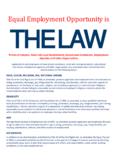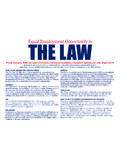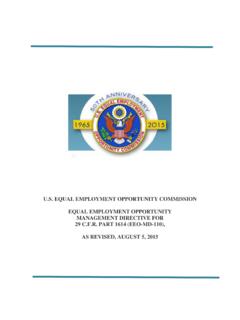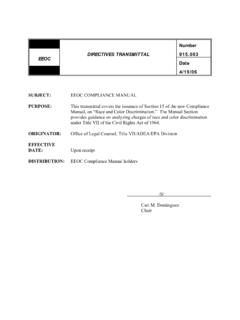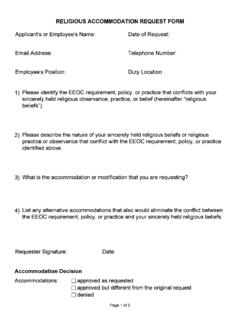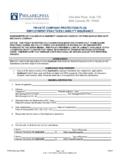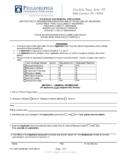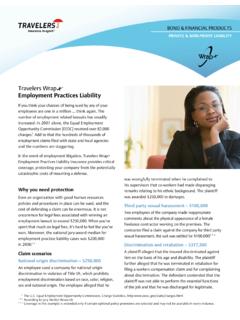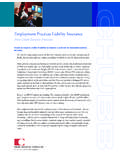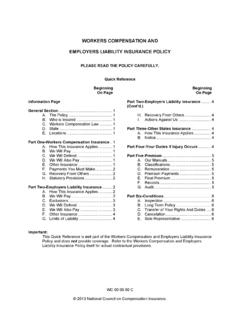Transcription of Number - Equal Employment Opportunity Commission
1 Number EEOC DIRECTIVES TRANSMITTAL Date 7/22/08 SUBJECT: EEOC COMPLIANCE MANUAL PURPOSE: This transmittal covers the issuance of Section 12 of the new Compliance Manual on Religious Discrimination. The section provides guidance and instructions for investigating and analyzing charges alleging discrimination based on religion. EFFECTIVE DATE: Upon receipt DISTRIBUTION: EEOC Compliance Manual holders OBSOLETE DATA: This Section of the Compliance Manual replaces Section 628: Religious Accommodation, EEOC Compliance Manual, Volume II and its Appendices: Appendix A, Policy Statement on Ansonia Board of Education v. Philbrook and Religious Accommodation; Appendix B, Policy Guidance On New Age Training Programs Which Conflict With Employees Religious Beliefs; and Appendix C, Religious Objections to Unionism.
2 It also replaces the following policy documents: Religious Organizations that Pay Women Less than Men in Accordance with Religious Beliefs; Religious Organization Exemption Under Title VII of the Civil Rights Act of 1964, as amended; and Policy Statement on Goldman v. Weinberger (Accommodation of the Wearing of Religious Dress). The Commission s Guidelines on Discrimination Because of Religion, 29 Part 1605, remain in effect. /s/_____ _ Naomi C. Earp Chair SECTION 12: RELIGIOUS DISCRIMINATION OVERVIEW ..1 12-I COVERAGE ..5 NOTE TO EEOC A. Definitions ..6 1. Religion ..6 2. Sincerely 3. Employer Inquiries into Religious Nature or Sincerity of NOTE TO EEOC B. Covered Entities.
3 15 C. Exceptions ..16 1. Religious 2. Ministerial 12-II Employment DECISIONS ..21 A. General ..21 1. Recruitment, Hiring, and Promotion ..21 2. Discipline and Discharge ..23 3. Compensation and Other Terms, Conditions, or Privileges of Employment ..24 B. Customer C. Security Requirements ..27 D. Bona Fide Occupational Qualification ..27 Employer Best 12 - III HARASSMENT ..29 A. Prohibited 1. Religious Coercion That Constitutes a Tangible Employment Action ..29 2. Hostile Work Environment ..31 a. Based on Religion ..31 b. c. Severe or Pervasive ..34 B. Employer Liability ..39 1. Harassment by Supervisors or 2. Harassment by Co-Workers ..41 3. Harassment by C. Special Considerations for Employers When Balancing Anti-Harassment and Accommodation Obligations With Respect to Religious Expression ..43 Employer Best Employee Best 12 - IV REASONABLE A. Religious Accommodation ..46 1. Notice of the Conflict Between Religion and Work ..47 2.
4 Discussion of Request ..48 3. What is a Reasonable Accommodation?..51 B. Undue Hardship ..56 1. Case-by-Case Determination ..57 2. More than De Minimis Cost ..58 3. Seniority Systems and Collectively Bargained Rights ..61 4. Co-worker Complaints ..63 5. Security C. Common Methods of Accommodation in the Workplace ..65 1. Scheduling Changes ..65 2. Voluntary Substitutes and Shift Swaps ..66 3. Change of Job Tasks and Lateral 4. Modifying Workplace practices , Policies and a. Dress and Grooming Standards ..71 b. Use of Employer c. Tests and Other Selection d. Providing Social Security Numbers ..75 5. Excusing Union Dues or Agency Fees ..75 6. Permitting Prayer, Proselytizing, and Other Forms of Religious Expression ..77 a. Effect on Workplace Rights of Co-Workers ..78 b. Effect on Customers ..78 7. Employer-Sponsored Programs ..81 NOTE TO EEOC Employer Best Employee Best 12 - V RELATED FORMS OF A. National Origin and B.
5 Retaliation ..90 Employer Best APPENDIX A ..92 APPENDIX B ..93 1 SECTION 12: RELIGIOUS DISCRIMINATION OVERVIEW1 This Section of the Compliance Manual focuses on religious discrimination under Title VII of the Civil Rights Act of 1964 (Title VII).2 Title VII protects workers from Employment discrimination based on their race, color, religion, sex, national origin, or protected activity. Solely with respect to religion, Title VII also requires reasonable accommodation of employees 3 sincerely held religious beliefs, observances, and practices when requested, unless accommodation would impose an undue hardship on business Undue hardship 1 This document uses examples that refer to the practices and beliefs of various religions. These examples are intended to clarify the legal principles for which they are used and do not purport to represent the religious beliefs or practices to which they refer.
6 In some instances, links to non-EEOC Internet sites are also provided for the reader s convenience in obtaining additional information. EEOC assumes no responsibility for their content and does not endorse their organizations or guarantee the accuracy of these sites. 2 This Section of the Compliance Manual replaces Section 628: Religious Accommodation, EEOC Compliance Manual, Volume II and its Appendices: Appendix A, Policy Statement on Ansonia Board of Education v. Philbrook and Religious Accommodation; Appendix B, Policy Guidance On New Age Training Programs Which Conflict With Employees Religious Beliefs; and Appendix C, Religious Objections to Unionism. It also replaces the following policy documents: Religious Organizations that Pay Women Less than Men in Accordance with Religious Beliefs; Religious Organization Exemption Under Title VII of the Civil Rights Act of 1964, as amended; and Policy Statement on Goldman v.
7 Weinberger (Accommodation of the Wearing of Religious Dress). The Commission s Guidelines on Discrimination Because of Religion (hereafter Commission Guidelines) are not affected by this Section. See Commission Guidelines, 29 Part 1605. 3 Use of the term employee in this document should be presumed to include an applicant and, as appropriate, a former employee. 4 42 2000e-2(a) provides that it is an unlawful Employment practice for an employer: (1) to fail or refuse to hire or to discharge any individual, or otherwise to discriminate against any individual with respect to his compensation, terms, conditions or privileges of Employment , because of such individual s race, color, religion, sex, or national origin; or (2) to limit, segregate, or classify his employees or applicants for Employment in any way which would deprive or tend to deprive any individual of Employment opportunities or otherwise adversely affect his status as an employee, because of such individual s race, color, religion, sex, or national origin.
8 42 2000e(j) provides that: The term religion includes all aspects of religious observance and practice, as well as belief, unless an employer demonstrates that he is unable to reasonably accommodate an 2 under Title VII is defined as more than de minimis cost or burden -- a substantially lower standard for employers to satisfy than the undue hardship defense under the Americans with Disabilities Act (ADA), which is defined instead as significant difficulty or expense. 5 The prohibition on discrimination and the requirement of reasonable accommodation apply whether the religious views in question are mainstream or non-traditional, and even if not recognized by any organized religion. These protections also extend to those who profess no religious Questions about religion in the workplace have increased as religious pluralism has increased.
9 In a 2001 survey of human resource professionals conducted by the Society for Human Resource Management and the Tanenbaum Center for Interreligious Understanding, 36% of human resource professionals who responded reported an increase in the religious diversity of their employees in the preceding five Further, the Number of religious discrimination charges filed with EEOC has more than doubled from 1992 to 2007, although the total Number of such charges remains relatively small compared to charges filed on other Many employee s or prospective employee s religious observance or practice without undue hardship on the conduct of the employer s business. 5 Federal legislation known as the Workplace Religious Freedom Act ( WRFA ), that has been proposed since the 1990s, would amend Title VII to change the current de minimis standard for establishing undue hardship to require employers to show that the accommodation would cause significant difficulty or expense.
10 See 1431, 110th Cong. (2007). This compliance manual chapter interprets and applies the current federal law, and takes no position on WRFA. Note: Various state and local laws extend beyond Title VII in terms of the protected bases covered, the discrimination prohibited or accommodation required, and the legal standards and defenses that apply. 6 See, , Torcaso v. Watkins, 367 488, 495 (1961) (First Amendment does not permit government to distinguish between theistic and non-theistic religions such as Buddhism, Taoism, Ethical Culture, and Secular Humanism); Young v. Southwestern Sav. & Loan Ass n, 509 140 (5th Cir. 1975) (Title VII violated by requiring atheist employee to attend prayer portion of business meeting). 7 Society for Human Resource Management (SHRM) and the Tanenbaum Center for Interreligious Understanding, Religion in the Workplace Survey, at 6 (Society for Human Resource Management, 2001) (executive summary and information on obtaining report available at (last visited July 2, 2008)); Pew Forum on Religion and Public Life, Religious Landscape Survey (2008), available at (last visited July 2, 2008).
